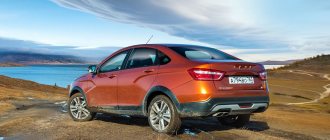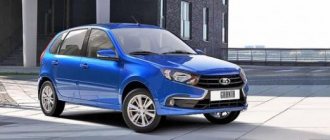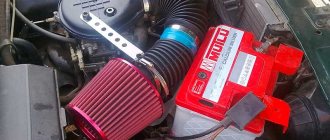When buying a car, it is difficult to make an unambiguous choice; at least a drop of doubt will always creep in about the correctness of your choice for 3-5 years (such statistics). Today we will put competing cars side by side and go over all the main parameters. You will be able to compare whether it is worth becoming the owner of a Lada Vesta or whether you should pay attention to a competitor. Is the quality of the Nissan Almera that much better, or did “Japanese quality” go away with the models of the late 90s and early 2000s? Meet the participants of the battle: a sedan produced by VAZ Lada Vesta vs Nissan Almera with a similar body. The prices of the cars are identical, the technical characteristics of the “engines” are practically indistinguishable. Due to the fact that the Almera has been sold in our country for a long time, and the VAZ product is a newcomer, it is surprising for everyone to see good reviews about the Lada Vesta.
Comparison of bodies and wheelbases
The body is the main part of any car (the most expensive repair). So we’ll start the review with its quality and size (the size of the cabin, the comfort of the driver and passengers, and the smoothness of the ride depend on this). The main disadvantage of the Almeria is the lack of choice among body styles (there are simply no station wagons or hatchbacks). In our country this is not a huge problem - most car owners prefer sedans. Let's start comparing body sizes: the Japanese model has a considerable advantage (4656 mm versus 4410 mm for the Russian sedan). Both competitors belong to the same B+ class; the Japanese product is close on the heels of its C-class competitors in terms of dimensions. The equipment is of course left behind. Apart from width: Lada Vesta takes the lead in this matter (1764 mm vs 1695 mm). When comparing heights, the palm goes back to the Japanese (1522 mm and 1497 mm). The wheelbase size is also on the sedan side from Japan (2700 mm). For the VAZ product it is 65 mm shorter.
What to choose: Lada Vesta or Nissan Almera
Both cars are bright representatives of the budget segment, but if you are convinced that any foreign car is better than a domestic car, then this is a good example of how such views become untrue. Yes, the Japanese sedan is still selling well, partly this is the result of such misconceptions, partly this choice is made due to the desire to have a real automatic. And there are those who simply need a more prestigious status as a car brand. But from the point of view of practicality, Vesta is definitely better, both in terms of power unit, and in driving performance, and in terms of equipment. Yes, even the appearance of our sedan is more modern and bright.
In any case, we advise you not to limit yourself to reviews, but to look at both cars in person, and, if possible, drive them, and only after that make your final choice.
Body paintwork and metal thickness
When they compare the quality of painting of the Lada Vesta with its Japanese competitor, many mistakenly take the side of the “foreign car”. This is called “the work of the Nissan marketing department,” plus the tarnished reputation of the Russian car plant over the years. In fact, the build/paint quality is about the same. Assembly is carried out in parallel at one plant (not all Japanese cars supplied to us are Japanese in origin). If the car has not undergone poor-quality body repairs (body work happens among new cars, because they are delivered by car carriers, anything can happen along the way) - nothing bad will happen to the paintwork during the warranty period. No significant difference in the thickness of the metal itself was noticed - everything was in accordance with established safety standards. Ordinary car owners are accustomed to comparing the thickness of metal by pressing on it (whether it will bend or not). Today this method seems unreasonable. To reduce vehicle weight, fuel consumption, and emissions, manufacturers are trying to reduce the thickness of the metal wherever possible. The power elements are still made of durable thick metal, only the “skin” is made as light as possible.
Chassis and ground clearance
There are those who are interested in what is better on the go, given the state of our roads: the Lada Vesta, or the arriving eastern rival. Let's compare the chassis and ground clearance of both cars. Technically, the chassis design is almost the same: there are MacPherson struts at the front and a torsion beam at the rear. The main difference is the setup. Despite the significantly higher ground clearance (178 mm versus 160 mm), the Vesta is more driver-friendly (compared to the Nissan Almera). It handles perfectly, the suspension developed by Russian engineers, and has almost standard energy intensity in its class. There are a small number of complaints about comfort when driving on rough roads, but overall our designers did their best by producing a balanced suspension. The “Russified Jap” has suspension settings for more imposing movement - the reason is the soft shock absorbers. When actively steering, there is excessive body sway and it rolls heavily. Fans of active driving in Nissan Almera need to change the factory-installed strut liners.
Quality of the trip on the Lada Vesta - real operating experience
But it’s worth noting right away that on paper everything looks much more beautiful than you can imagine in life. After the description above, you might think that this car has really become the best offer on the market. But during operation, the driver notices the VAZ breed, and this is inevitable. An immediate transition in build quality is impossible, although growth and development are really noticeable. During operation, two sensations arise:
- the car drives well and holds the road well, but the robot is constantly annoying, so it is better to give preference to a more affordable and reliable manual transmission;
- There are a lot of electronics and sensors in the car, this makes it possible to automatically control a number of functions, but from time to time this electronics simply goes crazy and works on its own;
- the assembly also makes itself felt, sometimes the door or hood sensors are triggered when closed, then the driver faces real discomfort in moving;
- The plastics in the cabin were chosen well, they are also well assembled, but there are also shortcomings in the combination of materials, some minor factory defects are visible that should not exist;
- The rear suspension wobbles a little at high speeds; driving above 120 km/h becomes a little uncomfortable, although this is an individual factor that depends on the driver.
If you really want, you can find just a lot of problems and unpleasant moments for the car. But it is also worth remembering that you are using the car for daily use, and not for transporting distinguished diplomatic guests. For its price range and for its tasks, Vesta is excellent. But the car still has shortcomings, and the buyer will have to come to terms with this. Although, even during the first year of its existence, the concern changed a lot in the model.
Salon of Almera and Vesta
Whose salon is more comfortable? In the previous categories, both sedans are on par with each other. We start with the Lada Vesta, comparing the interiors with the Nissan Almera. The Russian design in the cabin is definitely more interesting than that of the Almera. The West has a more comfortable driving position, providing better visibility. Inside, the Lada is more pleased with the more modern design of the torpedo along with the dashboard. When driving along the highway, there is no urgent desire to urgently carry out additional noise and vibration insulation. Nissan fails at this point of comparison. The only drawback of the Lada is that there is not enough space for tall passengers in the rear, “thanks” to the smaller distance between the front and rear axles. Being inside the “Japanese”, there are no particular complaints about the ergonomics, but what boring design colors! However, the relationship with the Logan can be traced to the naked eye: the torpedo design, single-color gray plastic, round air deflectors, and a center console tending downward. It is impossible to leave unnoticed the “luxury” in the form of “aluminum” inserts, as a result of which an unimportant feeling arises. The seats for Almeria passengers are comfortable. Even in the second row you can sit comfortably if the driver is up to 1.73 m tall. The dashboard is quite dull and you can’t help but feel like it’s 2007. In fairness, it is worth saying: all the necessary readings are read well. I don’t rule out the possibility that conservatives will prefer an interior similar to the new Logan – taste and color...
Interior
In interior design, Nissan Almera is significantly behind Vesta, although in all other respects they are almost identical. Almera's interior is boring, gray and monotonous, despite the fact that it is quite ergonomic. It should also be noted that the dashboard is convenient and the seats are comfortable, especially the freedom for rear-row passengers, which makes Nissan convenient for use by a large family. But the sound insulation let us down.
Lada Vesta looks much nicer inside. Ergonomics are not inferior to Nissan, and comfortable seats are equipped with additional heating of the front seats.
We also note that noise insulation and visibility are much better than those of its closest competitor. In terms of passenger safety, the Lada Vesta has everything that the Nissan Almera has, and is additionally equipped with a hill start assistance system.
In terms of comfort, AvtoVAZ developers also surpassed their Japanese competitors by providing Vesta with air conditioning, rear parking sensors and a cooled glove compartment (Almera has none of this).
Engine Comparison
Who drives better and is more economical for the owner? Both vehicles have no alternative front-wheel drive.
Engines for the Nissan Almera can only be offered to the buyer: naturally aspirated 16-valve petrol engines with a volume of 1.6 liters.
Vesta comes with a 1.8 liter power unit, detailed information about which can be found on the official websites), mated to a manual transmission and an automatic transmission.
First of all, let's compare the characteristics of smaller engines: the Nissan Almera has 102 “horses” at 5750 rpm and a torque of 145 Nm, available at 3750 rpm. A manual transmission and front-wheel drive are capable of accelerating a car to hundreds in 10.9 seconds; combination with an automatic transmission slows the car down to 12.7 seconds, but makes it more comfortable for city driving. The maximum possible speed is 185 km/h. Lada Vesta has a well-known domestic engine with a power of 106 hp, the peak of which is reached at 5800 rpm, and all 148 nm of torque are available at 4200 rpm. The first “hundredth” is reached at the “handle” in 11.8 seconds, the robotic automatic transmission adds +1 second to acceleration. It will not be possible to accelerate more than 178 km/h on the fret. It's time to touch on the topic of fuel consumption: in the urban cycle, the compared cars, regardless of the type of gearbox, consume a little more than 9 liters/100 km. Almera can be “fed” with AI-92 gasoline, Vesta only requires refueling with 95.
When driving on the highway, fuel consumption naturally decreases to 5.5 liters for a domestic product and 5.8 - 6.5 liters for a product from Japan. As a result, we can state: Nissan Almera & Lada vesta have no differences in fuel costs.
FakeHeader
Comments 255
It’s better to take a grant or viburnum for 450
This is my second year riding on a grant. has never let me down. a car for both work and family. very comfortably. Spare parts are probably cheaper than for Almera. yes, even if you take THAT. Personally, nothing rattles or sticks together. I have a sedan. accelerated to 180.150Km/H and doesn’t feel much. It’s up to you bro! good luck with your choice!
Yes, I think the grant looks prettier, but the characteristics depend on the configuration
Topic closed, disappointed in both candidates, they both failed the salt fog test and rusted
what kind of comparison is there money, take the Almera, it’s a spacious, excellent car and nice for my money, my friend bought it from me before, he drove a Priora, he really likes it, if money is a bit difficult, take the Grant - Everything is very simple in my opinion
It seems to me that they will break the same way, but the spare parts for the Almerka will be more expensive!
Take the grant and don’t break your head. It’s a great car, if you want more comfort, more reliability, more style, then this is not an Almera for 470 thousand, it’s a crap Cruz for 570
Machine warranty
When buying a car “from scratch” at a car dealership, the buyer hopes for a so-called guarantee. Are there really hidden deceptions? Let's clarify the main points, starting with the news:
AvtoVAZ gives a warranty on the car for a period of 3 years or 100 thousand km (with many nuances, since some spare parts have a significantly shorter warranty period, about which the consumer is notified by the documents attached to the car); body protection against through corrosion is guaranteed for a period of 6 years; must be serviced by a dealer in compliance with its requirements; keep the warranty card and service book; Use only those spare parts and technical fluids recommended by the manufacturer. More detailed information is provided in the warranty card. The conditions for providing a warranty for Nissan differ insignificantly:
the same 3 years or 100,000 km; the body of the Almeria will definitely not be covered with holes in 6 years; if paint defects are detected no later than 36 months from the date of purchase (regardless of the numbers on the odometer), the defect will be eliminated free of charge; If repairs under warranty last more than 4 hours, the client has the right to demand a free replacement car of a similar class (they can be provided with a higher class).
For originals
If you are a fan of the “French”, then as an alternative you can consider the Peugeot 408 sedan assembled in Kaluga. This car formally belongs to the C-class. In the secondary market there are several cars with a 150-horsepower gasoline engine. Moreover, for 600 thousand you can find a car with only 50 thousand kilometers, manufactured in 2016.
There will also be side airbags, 2-zone climate control, and an audio system with Blueooth. The offer seems very tempting, but before purchasing it is still worth conducting a thorough technical inspection.
The design of the Peugeot 408 sedan is far from the elegance of a hatchback, and the platform is old. In addition, these cars were used quite often in taxis (never trust the stated mileage). But the 150-horsepower engine is paired with a fairly reliable automatic transmission, which cannot be said about the 120-horsepower version with the notorious AL4 - the curse of the entire PSA concern. In 2011, it was modernized and even changed its index to AT8, but most of the “childhood diseases” have not gone away.
Options, prices
In total, the Lada Vesta has 7 options for various types of equipment versus 5 for the Almeria. The basic equipment of the domestic Lada can give odds to the “base” from Nissan, and it costs as much as 25 thousand (514 versus 539) less! This is the secret to the growth of Lada Vesta sales. Almera as standard has ABS, EBD systems, electric drives for opening front windows, 2 front airbags, and 15-gauge steel wheels. Vesta will have additional options available for less money: heated side mirrors with electrical adjustment;
steering column adjustment in 2 planes;
on-board computer and a lot of little things for comfort.
Versions similar to the basic ones, but with automatic transmission, are priced at: Lada - 569,000 rubles versus 633 thousand “wooden” for the Japanese.
The trunk of models is important
We almost forgot about comparing luggage compartments! It's a mess, let's fix it: both four-wheeled rivals have a fairly large trunk with a wide opening for easy loading. The trunk volume is slightly more impressive in the Almeria and is 500 liters versus 480 for the domestic workhorse.
What if it’s not a sedan, but a crossover?
Or maybe give up buying a sedan and opt for a crossover? If you look at cars no older than 2016, the choice is very small. And these will be front-wheel drive cars made in China. You will have to choose from only two brands of models: Lifan and Chery.
The first generation X60 crossover, popular with Lifan, has a 1.8-liter engine producing 128 hp. and a CVT can be found even cheaper: for 600–620 thousand rubles for a 2016 car. True, the mileage will be close to 80 thousand kilometers. The equipment is not the poorest: the interior is upholstered in leatherette, there is an audio system with USB, two airbags and ABS. The machine is quite common, so there should not be any problems with its maintenance and repair. But you should approach the purchase with extreme caution: we came across two mortgaged cars, two with VIN codes that did not match the advert and one that had been in an accident (the seller, naturally, writes about “factory paint all around”).
For approximately the same amount you can find (if you try really hard) a Chery Tiggo 5 with a 2-liter engine (139 hp) and a CVT. The car will be three years old with a decent mileage (from 20 thousand kilometers per year) and not in very good condition. The package also includes two airbags, ABS, an audio system, and leather seats. The weaknesses of this model have long been studied, so there should be no problems with spare parts or repairs.
Of course, you can look at older cars, then the equipment will be richer, and the choice will be wider among both sedans and crossovers. But if you are choosing between Vesta and a used foreign car, Behind the Wheel recommends not buying a car older than three years. Otherwise, you will have to spend much more on possible repairs. In addition, do not forget that our Lada Vesta is new, which means it is under warranty and most of the possible problems will be fixed for free.
A few words about design
The designers made the appearance of the Vesta more aggressive by drawing an impressive radiator grille. X-shaped stampings on the sides and a chrome “X” on the front indicate the “evil character” of the car. On the trunk lid, the huge letters LADA symbolize that this is a product of the Volzhsky Automobile Plant. Almera's design is more solid. According to the Japanese idea, it should become a smaller copy of the theana, which will make the appearance more solid. Both cars have the right to exist and only the buyer must make a choice in one’s favor.
Exterior
But here the differences are already clearly visible. The Japanese decided not to reinvent the wheel, but simply make a smaller copy of Teana. It turned out well, but many consider Almera’s appearance to be at least unbalanced. In addition, not everyone likes the excessive severity of the outlines.
Lada Vesta
The designers of Lada Vesta were guided by completely different principles, deciding to prove that a budget car can look bright and attractive. And not without success either. The signature X-shaped design looks fresh and interesting, and it was on Vesta that it was tested and used in other Togliatti models. It can be argued that Vesta’s exterior is youthful and moderately aggressive, while the budget Japanese car has all the design details aimed at showing that this is a solid car. In a word, both models turned out to be recognizable, but which is better is up to the end consumer to decide. As they say, “there are no comrades according to taste”...
Transmission
The gearboxes on the tested cars are mechanical (everything is extremely simple, although the Vesta's switch stroke will be a little more pleasant) and automatic. Nissan will offer us a regular “automatic” with 4 gears, but VAZ, in order to reduce the cost of production, decided to install a robotic gearbox. In comparison with the Japanese automatic transmission, the VAZ robot pleased with its lower fuel consumption, but was disappointed with the occasional jerks and incomprehensible operation. You need to get used to a robotic gearbox (in our case, a manual transmission with an actuator that changes gears instead of the driver).
Is it cheaper?
For 635–650 thousand rubles you can find a Nissan Almera assembled in Izhevsk, and you can come across cars with very low mileage and additional equipment (for example, a non-standard audio system with a large screen and a rear view camera, an alarm and tinted rear windows). The sedan has a 102-horsepower gasoline engine under the hood, coupled with a time-tested 4-speed automatic transmission.
Once you get into the Almera salon, don’t be surprised that you could already see it on another model. Yes, this is the “seamless” interior of the first generation Renault Logan. With all its cheap materials, annoying ergonomics and not the highest seat comfort.
But such a car causes a minimum of problems. But service at Nissan branded service stations will cost more than Vesta from official dealers.











